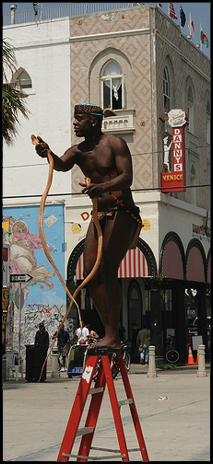
Venice, California, has been a city of Beats, hippies, and progressives of many stripes, and thanks to the beachfront culture and the ghetto-ish Oakwood area, it has always been a very “street” kind of place. Also, there are neighborhoods where people have lived for many years. St. Joseph Center has existed in its midst, in the local’s “backyard” so to speak, for more than three decades.
There is a café called Bread and Roses that serves people experiencing homelessness. Clients can send and receive mail, make phone calls, wash their clothes, or wash themselves. There is a thrift store. The staff members and volunteers (around 400) do a lot of things, like find emergency shelter and medical help for clients, and that includes people who might be mentally ill or substance abusers, or both. The Center offers various kinds of aid and advocacy in applying for benefits.
St. Joseph Center’s website states,
Homeless individuals who are ready to make long-term change may enroll in case management. Service plans developed jointly by the individual and the case manager assess each person’s strengths and needs and lay out a pathway to long-term stability and increased self-sufficiency by addressing issues such as permanent housing, job training, employment and ongoing treatment.
The part about the long-term change enrollment seems unknown to some of the neighbors, who don’t understand the levels of participation possible at the Center, and believe that all the clients must be fully enrolled in order to take advantage of the services.
I used to live within blocks of the Center, which was founded by nuns in 1976, so it was almost brand-new in my day. In 2006, the new main service center (family service and administration) was built on Hampton Drive, as described in this piece by Suzanne Thompson, in the Free Venice Beachhead (PDF),
Despite being so venerable, the institution has been embattled for years. I don’t live there anymore, but have followed the controversy through the neighborhood newsletters and other publications from Venice. Many of the neighbors equate the clients with criminals. Some are, some are not, and the same is true at any facility of this kind. A lot of people have records. A lot of people have been locked up at some point in their lives. (If you know a hundred people, one of them is in jail.) If they did their time, they’re even. Theoretically, here in America, a person with a criminal record has the same right to a free bowl of soup as anybody else.
There are always complaints about human excrement in the area. Why is that? It seems like, after the first year or so, the Center and/or the city would have figured out the restroom problem. The neighbors hate graffiti, and having their car windows smashed with bottles (or possibly from the impact of somebody’s skull). Some neighboring homeowners and renters live in constant fear. Others summon up their spiritual ideals or their old-school 60’s spirit, and try to exercise tolerance while they cope.
Some neighbors feel general compassion, but are exasperated by individual cases. They bring up the “homeless by choice” argument. It is true that throughout the history of the world there have been people who prefer to be vagabonds, and some prefer it now. But not nearly as many as the housed neighbors want to believe. Some call the center an “enabler,” and believe that any such facility that offers services to people experiencing homelessness will only encourage the lifestyle. Others disagree, such as Lars Eighner, who was quoted on this subject by House the Homeless a few days ago.
Almost a year ago, Va Lecia Adams, executive director of the homeless center, told Tidings Online:
We’ve always served families but, proportionally, we are seeing more families now. Certainly housing has been a very serious issue for our families. And I think so many families are just on the brink. When a member loses his or her job, it all can just crumble — especially in Santa Monica and Venice, where people are fighting to keep their housing.
At that time, the Center was serving 150 hot meals a day, and giving out thousands of bags of groceries. Donations were down, the staff was cut. Things have only gotten worse since then. There was a bright spot in September, when the Venicestock Festival with its seven bands raised money and awareness for the Center to continue its work. St. Joseph Center is currently, by the way, looking for a Manager of Venice Chronic Homeless Intervention Projects.
Reactions?
Source: “Homeless Services,” St. Joseph Center
Source: “Our History,” St. Joseph Center
Source: “St. Joseph Center struggles to serve Westside’s needy,” The Tidings Online, 01/29/10
Image by Steven W. Belcher, used under its Creative Commons license.


